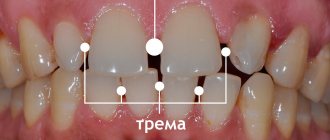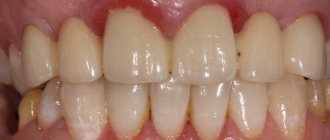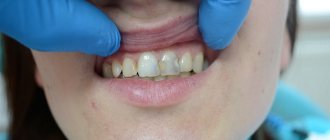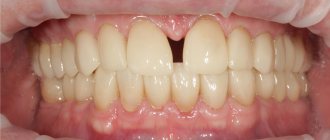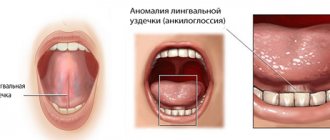Problem: For about five years, a man suffered from food getting between his teeth. Food getting stuck meant that I constantly had to pick between my teeth to remove food debris and my gums became inflamed. Friends advised me to contact Dial-Dent to eliminate the gap between my teeth.
Solution: old crowns on the teeth were replaced (the crowns were more than 5 years old, they were done in another clinic). Using computer modeling, tight contacts between teeth were created and the anatomical shape of the chewing surface was restored. Now food does not get between the teeth, it is chewed better, and the gums do not hurt. With new ceramic crowns from Dial-Dent, the problem is completely solved.
Choosing treatment tactics for food stuck between teeth
At the consultation, orthopedic dentist S.V. Zukor discovered that between the chewing teeth on the lower jaw there is a gap where food gets clogged. Due to food getting stuck between the teeth, the gums are constantly pressed, and the use of various improvised means for picking between the teeth injures the gums even more, so the gums hurt. The teeth have crowns that do not have the correct shape, there is no close contact between the teeth, and the chewing surfaces are almost flat.
To eliminate food getting between the teeth, the dentist suggested replacing the old crowns and making new ones with tight contact so that there is no gap between the teeth.
Why does food end up between teeth?
In dentistry, there is the concept of a contact point. This is the name given to the point of contact between the lateral surfaces of two adjacent teeth. The function of the contact point is to protect the gingival papilla from injury from pieces of chewed food. The papilla itself protects the interdental space from food entering there. Therefore, when the contact point is destroyed, problems begin.
This problem can arise for various reasons:
- due to poor-quality treatment of caries and incorrectly placed fillings - for example, when the anatomical relief of the tooth being restored is not accurately reproduced;
- in case of poor-quality dental prosthetics - with the formation of an overhanging edge of the crown, with its contour being too wide, due to cement remaining on the surface after fixing the crown, or due to an incorrectly designed hanging part of the bridge.
But the anomaly is not always caused by dental errors. Very often, food gets stuck in people with disturbances in the natural structure of the dentition: with crooked, tilted and crowded teeth, with a diastema - a gap between the upper or lower incisors, or with trema - gaps between the lateral teeth.
In addition, food remains in carious cavities and in interdental spaces formed after injuries and professional tooth extraction. Tartar formed above and below the gum also contributes to the sticking of pieces, which provokes the development of periodontal diseases.
Dental scanning and dental crown modeling
Before modeling the new crowns, a teeth scan was performed. Dental scanning replaces traditional dental impressions, which many patients cannot tolerate due to an increased gag reflex. When taking digital impressions of teeth, the dentist runs a Sirona scanner along the surfaces of the teeth for several minutes, and a three-dimensional image of both jaws is transferred to the computer - a digital impression of the teeth.
Working with a digital impression in a specialized program, the dentist models crowns with the most tight contacts between the teeth and the correct anatomical chewing surface.
Based on the simulation results, the dental technician produced ceramic crowns from E.max ceramics. Pressed ceramics E.max has high strength and excellent aesthetic properties, therefore it is used for prosthetics of both lateral and anterior teeth.
What causes food getting stuck in teeth?
As a rule, those patients who become annoyed by the need to constantly remove food debris turn to a dentist for advice. They can be understood: over time, this procedure begins to take more and more time. Many people also note the appearance of bad breath. But these are only the very first signs of an unresolved and therefore progressive problem.
- By injuring the gingival tissue, food debris over time causes chronic inflammation, which is invisible to the patient due to its sluggish nature.
- Constant use of toothpicks and floss aggravates inflammation, transforming it into gingivitis and periodontitis. In the absence of treatment, in addition to the unpleasant odor, the patient will sooner or later be faced first with exposure of the tooth roots, and over time with loosening and premature loss of the teeth themselves. This is explained by the gradual resorption of the bone interdental septa adjacent to the source of inflammation.
- Poorly cleaned dental spaces become a breeding ground for pathogenic microflora that affects the contact surfaces of the teeth. Caries in these places is difficult to recognize at the initial stage and often manifests itself as severe pain already at the stage of development of pulpitis.
The result of replacing crowns is that food does not get stuck between the teeth
Tight contacts between teeth ensure that food does not get stuck and gums remain healthy.
The cost of ceramic crowns is 55,000 rubles per unit.
Of course, it is possible to make dental crowns cheaper (cheaper material, lack of computer modeling, etc.), but this will invariably affect the quality. The use of computer technology makes it possible to more carefully work out the shape of the crowns, provides additional convenience when taking impressions - all this is reflected in the price, so good dental crowns cannot be cheap. In addition, Dial-Dent uses the highest quality and most modern materials both for the crowns themselves and for their fixation, which increases the service life of dental restorations.
Video about how teeth are scanned with an intraoral scanner:
How is the problem corrected in the clinic?
The main thing in treatment is the correct formation of the contact point. A wide variety of matrix systems and filling materials will help to successfully treat caries. The filling must not only be placed, but also given the correct shape in order to achieve tight contact with the adjacent tooth. If the problem of food getting stuck is caused by an overhanging edge of the filling because the previous dentist gave it the wrong shape, then the filling will be changed. Dentures of unsatisfactory quality must be replaced. “Black triangles” and deep pockets are corrected by dental surgeons. There is no way around it without surgery. Teeth crowding, spasms and diastema can be corrected with orthodontic therapy. To eliminate these defects, it is better to use the method of aesthetic restoration of teeth with crowns, veneers and fillings. Tartar is removed using a special procedure using a professional method, followed by root polishing.
Veneers are microprostheses that restore the aesthetic appearance of teeth, allow you to choose the color and shape of one or a group of teeth, and eliminate interdental spaces.
How to maintain healthy teeth and gums for a long time and extend the life of dental crowns
The dentist said that to maintain healthy teeth and gums, it is necessary to undergo professional teeth cleaning at least once every six months. Dial-Dent understands the importance of prevention and oral hygiene, so they have developed the “Teeth for Life” program. Professional oral hygiene helps remove plaque not only from your teeth, but also from crowns, veneers, implants, thereby extending their service life, and prevents the occurrence of caries, periodontitis and other diseases.
See other examples of the work of Family Dental specialists here.
Make an appointment for a consultation by phone +7-499-110-18-04 or through the form on the website. You can ask questions about dental prosthetics to the chief doctor of the clinic, Sergei Vladimirovich Tsukor, at
Causes
There are many reasons why food gets stuck between teeth over and over again:
- incorrectly recreated contact points in the treatment of caries,
- low-quality artificial crown or cement residues after its fixation,
- abundant supra- and subgingival deposits,
- malocclusion.
And if the other reasons for the problematic situation are, in general, clear, then how an incorrect bite can affect food getting stuck is not obvious. Let's look at this in more detail.
Normally, the crown parts of adjacent teeth should be in close contact with each other. The places of their contact are called contact points. It is these that are so important to restore when filling a carious cavity, so that caries does not occur again in the same place. The condition of the periodontal papilla, the area of gum in the interdental space necessary to protect the neck of the tooth and the interalveolar septum, also depends on the quality of the contact points.
If the papilla disappears, food will begin to get trapped under the gum and then the roots of the teeth will deteriorate. In addition, when food gets stuck between the teeth and puts pressure on the interdental papilla, pain occurs, and the decomposition of food debris contributes to the appearance of bad breath, the development of inflammation, which ultimately can lead to consequences such as periodontitis and premature tooth loss.
Incorrect posture, the habit of holding your head low, scoliosis or any other spinal deformity causes overstrain of the neck muscles, which in turn leads to asymmetrical spasm of some and relaxation of other facial muscles. Prolonged stay in this state causes an imbalance in the facial-masticatory muscles, which ultimately leads to a change in the position of the teeth.
This process occurs slowly and often goes unnoticed. But over time, some people may experience crowding, while others, on the contrary, may have teeth that diverge. In this case, some teeth may change their position relative to the vertical axis. All these factors lead to the formation of malocclusion. Wide dental spaces or, conversely, narrow ones, are the places where food gets stuck between the teeth. Thus, it turns out that postural disturbances can cause food to accumulate between the teeth.
Brushing too hard
Also, in the fight for oral health, it is important not to overdo it. Excessive brushing of the teeth and frequent use of hygiene products can also lead to damage to tooth enamel. In addition, the focus of gum inflammation requires the consumption of calcium in large quantities. The body begins to respond to this requirement by taking all the calcium from the bone plates that surround the inflamed area.
When the very first signs of this problem appear, you should immediately seek help from an Irrigator. Since inflammatory processes generally develop completely unnoticed, and treatment takes a lot of health and strength, it is better to resort to the help of a trusted source, the Irrigator.
Interdental spaces or why an Irrigator is necessary
Diagnosis and treatment
Has a pocket formed under the crown? To determine the cause of the pathology:
- carry out an examination of the oral cavity,
- take a photo.
Treatment may include:
- removal of soft bacterial plaque and hard dental plaque;
- curettage – thorough cleaning of pockets;
- vestibuloplasty;
- splinting – can be temporary or permanent, aimed at stabilizing the position of teeth in the sockets.
If a pocket has formed under an artificial crown, it may need to be removed and re-treated. In case of extensive inflammation, the affected tooth is removed.
Treatment of caries in the Lazarevsky district of Sochi
- What is caries?
- What determines the cost of caries treatment?
- Why does food get stuck between teeth?
- The service life of a filling and what does it depend on?
- The seal is stained around the edges. Does it need to be changed?
- Why does a filling fall out?
- Why shouldn’t you wait for the filling to “grind in” on its own if it is too high for your bite?
- Which filling is better?
- What is better, a filling or an inlay?
- Why do fillings change color over time?
- Why is it necessary to restore a tooth with a pin?
1) What is caries?
Caries is the most common disease known (97%).
People have suffered from tooth decay and its complications for many centuries (you can even remember the American president with a $100 bill). So what is it? In simple terms, caries is the destruction of hard tooth tissue. And the reason for its appearance is simple: food debris stuck to the teeth and not cleaned off with a toothbrush in time is an excellent environment for bacteria to live and reproduce. The acids released by them affect the tooth enamel, causing damage to it. The enamel becomes loose and weakened, and bacteria, breaking through this barrier, penetrate deeper, destroying the tooth from the inside.
Often, caries can be compared to an iceberg. On the enamel side we see slight damage, but inside there is a much larger cavity. And the larger it is, the more difficult dental treatment can be. At the same time, caries detected at an early stage is easier and cheaper to treat.
That's why we recommend not to neglect prof. examinations once every 6 months.
How to treat caries?
Caries is destroyed, non-viable tooth tissue. Unfortunately, it is no longer possible to return them to a healthy state, but with the modern development of technologies and materials in dentistry, caries treatment is a simple and painless procedure.
First of all, it is important to clean the tooth of all damaged tissue, and then fill the formed cavity with filling material, and restore the functional and aesthetic integrity of the tooth.
The seal can be made in two ways:
- If the carious process is relatively small, then the tooth can be restored in one visit by placing a photopolymer filling.
- If the cavity is very large, affecting 2 or more surfaces of the tooth, then the dentist may recommend that you restore the tooth with a ceramic or composite inlay. Such a tab will be more functional, reliable and durable.
2) What determines the cost of caries treatment?
Treatment directly depends on the severity of the disease. Treating caries in the early stages is much easier, faster and cheaper. The longer a patient delays visiting a doctor, the more the tooth is destroyed, and the more expensive its treatment can be.
The cost of caries treatment in the Lazarevsky district of Sochi may depend both on the stage of tooth damage and on the materials and equipment that the dentist uses when working with the patient. A large number of dentists practice in Lazarevskoye, the prices and quality of their services vary greatly.
3) Why does food get stuck between teeth?
Normally, adjacent teeth are quite close to each other, which prevents large pieces of food from getting stuck between the teeth.
For a number of reasons, this contact can be weakened and is the cause of constant discomfort from food getting stuck. The most common reason is an incorrect filling. Firstly, the filling may not fit tightly enough to the adjacent tooth; secondly, a filling on a non-contact surface may have an overhanging edge, which will make it difficult to clean the interdental space. Another reason is periodontal disease (periodontitis), as a result of which the roots of the teeth are exposed, spaces appear between the teeth that are not protected by the gums, tooth mobility occurs, due to which the contacts between the teeth are weakened.
The next reason is malocclusion pathology, when the teeth are not positioned correctly, outside the dentition.
Be that as it may, if food gets stuck between your teeth, this is a reason to see a dentist. Since, in addition to constant discomfort, this can lead to caries and gum inflammation.
4) The service life of the filling and what it depends on.
The service life of a filling is the period after the expiration of the warranty period during which the filling meets aesthetic, clinical and functional requirements. That is, roughly speaking, this is the period of time between the placement of the filling and the need to replace it.
Service life depends on several factors:
1) The professionalism of the doctor and compliance with the filling technology, 2) Oral hygiene, depending on the characteristics of the bite. 3) Regular professional hygiene and grinding of fillings every 6 months.
I. We have already written about the importance of following all stages of the filling protocol. Unfortunately, the patient cannot track these stages because he is not familiar with all medical aspects, but there are nuances that are worth paying attention to:
1) The use of a rubber dam system, which allows you to ensure dryness and sterility of the working field, and the absence of micro-leakages. 2) Working with an assistant with 4 hands allows the doctor to fully concentrate on the treatment process. 3) The doctor’s use of caries markers, which allows, in doubtful cases, to make sure that all carious tissues have been removed. 4) The filling after grinding and polishing should not have sharp edges, the surface should be smooth. 5) If the filling is adjacent to an adjacent tooth, then the floss should pass between the teeth to the end, but with little force.
This is important so that food does not get stuck between the teeth.
II. Oral hygiene is a very important aspect of extending the life of any oral restoration, including fillings. Poor hygiene negates the efforts of the most highly qualified dentist, and caries can occur under an ideal filling. The patient must understand that if he was unable to keep his teeth healthy, then he should not expect that the dentist will be able to do better than what nature created, and forever.
III. Regular professional hygiene during which the dentist checks the fit of previously placed fillings and their grinding.
Any filling material experiences compensatory shrinkage over time. In photopolymer composites, the main shrinkage occurs at the moment the material is illuminated by a lamp, but during natural operation it still continues. After some time, the filling begins to “cling” and requires sanding. The filling-tooth boundary is the “weakest” place for recurrent caries.
During professional hygiene, plaque is also removed, which is fixed in places that are difficult to reach with a toothbrush, which also prevents recurrence of caries under the filling.
Thus, the service life of the filling depends on many factors, and if you follow all the doctor’s recommendations and there are no bite pathologies, it averages 5-7 years.
5) The seal is painted around the edges. Does it need to be changed?
The filling-tooth boundary is the “weakest” point of any filling. A change in the color of the edge of the filling can be caused either by staining with various dyes (tobacco, coffee, tea, etc.), or by the occurrence of relapse of caries in this place.
A dentist can evaluate the cause.
If it is just staining, then the filling can be sanded down to remove pigmentation. If the cause is caries, then it is better to replace the filling without waiting for the tooth to decay even more. Terekhova Tatyana
Dentist-therapist
Karapetyan Grigor
Dentist
6) Why do fillings fall out?
Modern pathologies and materials in dentistry make it possible to produce fairly durable restorations. But sometimes fillings fall out. If a filling falls out shortly after treatment, the reasons are usually the following:
- Violation of seal manufacturing technology
- Leakage of saliva during filling placement
As a rule, if this is the reason, then the filling falls out during the warranty period, and the doctor will replace the filling under warranty.
Other reasons may be:
- Recurrence of caries under a filling
- The occurrence of caries on another surface of the tooth and its spread under the filling
- Violation of the integrity of the seal itself during its natural operation
- Functional overload of the filling due to the patient’s incorrect (pathological) bite.
In any case, if a filling falls out, you should immediately consult a doctor.
7) Why shouldn’t you wait for the filling to “grind in” on its own if it is too high for the bite?
Fillings or ceramic inlays are usually placed under anesthesia. And often the patient cannot accurately understand whether the restoration immediately interferes with the bite. But after several meals you can feel it.
In this case, you should definitely contact your dentist to adjust the height of the filling or inlay.
Modern dental materials are highly durable, and the filling will not rub against the teeth.
But the appearance of pain when biting on a tooth, caused by overload of this tooth, is more than likely. In addition, due to the overestimation of the restoration, it is possible for it to chip.
 Which filling is better?
Which filling is better?
Our patients ask this question quite often. As a rule, they are interested in 2 aspects: photo filling or chemical curing and the manufacturer (Japan, Germany, etc.)
Let's look at it in order: of course, when choosing between a photo-curing filling and a chemical-curing filling, preference should be given to the first. Photocomposite material is more modern, and in its properties, including aesthetic ones, is head and shoulders above its predecessor.
As for the manufacturer of the materials, does this make sense for a patient who does not know how different fillings differ from each other? When placing a filling, what is much more important is not the manufacturer, but the observation of the technological treatment protocol.
Ensuring the working field (cofferdam system) is dry, removing all affected tooth tissue, as well as caries. A large number of other nuances.
As a result, the service life of any filling depends primarily on the skill of the doctor, and not on the manufacturer of the material. If there are important nuances, the doctor will definitely inform you about it.
9) Which is better, a filling or an inlay?
Filling - serves to restore tooth tissue lost as a result of caries. The development of modern materials makes it possible to create fast, aesthetic, functional and durable fillings.
But the modern filling still has a number of disadvantages:
- Compensatory shrinkage during material curing,
- The appearance of internal deformations in the material,
- With large defects, it is impossible to control the marginal fit along the entire border of the filling.
That is why, for large defects, the use of fillings is limited.
And this is where tabs come to the rescue.
An inlay is essentially the same filling, but made on a model in a dental laboratory.
To make inlays, either precious metals or ceramics are used. Ceramics are very similar in properties to tooth enamel.
A ceramic inlay glued to the tooth with special glue completely restores the strength of the tooth and its functionality. Also, the inlay manufacturing technology allows you to control the accuracy of the inlay’s fit to the tooth, avoid overhanging edges of the restoration, and ensure tight contact with adjacent teeth.
In many cases, when tooth decay is severe, but the tooth is still alive, an inlay is the only way to avoid crowning and depulping the tooth (nerve removal).
An inlay, unlike a filling, is made in two visits. During the first appointment, the doctor removes caries, creates a cavity, and takes impressions of the upper jaw and lower jaw. And a temporary filling is placed in the tooth. The impressions are sent to the laboratory, where a dental technician casts models and makes a ceramic inlay on the model. Ceramics are baked in an oven at a temperature of 1050-1100 degrees Celsius. At this moment, all compensatory changes in the material occur.
During the second visit, the doctor fixes the tab into the patient’s tooth. A ceramic inlay is not only stronger than a filling, it is also more beautiful, more practical, and more durable. Plaque does not settle on it, it does not change color over time and does not irritate the gums.
10) Why does the filling change color over time?
Modern materials used for filling teeth are light-curing composites. This material is durable, aesthetic, and allows you to solve many problems. But one of its drawbacks is that it “absorbs” dyes. Stained by coffee, tea, cigarettes and so on. Of course, this happens slowly, but a change in the color of the filling may cause it to be replaced (if it is, for example, a front tooth).
Another reason for a change in the color of the filling is the occurrence of caries under the filling. The tooth under the filling darkens and the filling changes color.
If you notice that the filling is changing color, you need to contact your dentist.
11) Why is it necessary to restore a tooth with a pin?
In case of severe tooth decay, after root canal treatment, it becomes necessary to create additional elements to fix the filling.
Intracanal pins help with this. A pin is fixed into one of the channels (the widest and straightest) with special cement. The cavity is then filled with filling material.
The clinic administrator will be happy to answer all your questions: | Make an appointment with a doctor at our clinic for an examination: |
| ORDER A CALL-CONSULTATION | MAKE AN APPOINTMENT |
Reasons for formation
The main reasons for the appearance of pockets:
- gingivitis and other inflammatory diseases in which the gums become loose and swollen;
- insufficient oral hygiene;
- tartar – hard deposits injure soft tissues;
- malocclusion.
The risk of pocket formation under the crown increases with regular smoking, eating mostly soft foods, and after dental prosthetics. If the denture does not fit in size or is made of materials that cause allergies, the gums become constantly inflamed and may detach from the crown.
Possible diseases
Constant pain in the gums is one of the main symptoms of the following oral diseases.
- Gingivitis. Acute or chronic inflammation of the mucous membrane. Develops due to the accumulation of plaque. Soft deposits mineralize and turn into tartar, which cannot be removed with a regular brush. Pain occurs in the gums between the teeth.
- Periodontitis. Periodontal inflammation, in which the dentogingival joints are destroyed. Develops due to advanced gingivitis. The risk group includes patients with a hereditary predisposition to the disease.
- Stomatitis. An inflammatory process accompanied by the formation of blisters or ulcers. They cause burning and pain in the mouth when eating and brushing teeth. Stomatitis can be triggered by injuries, burns, as well as pathogens - herpes simplex virus, Candida fungi.
